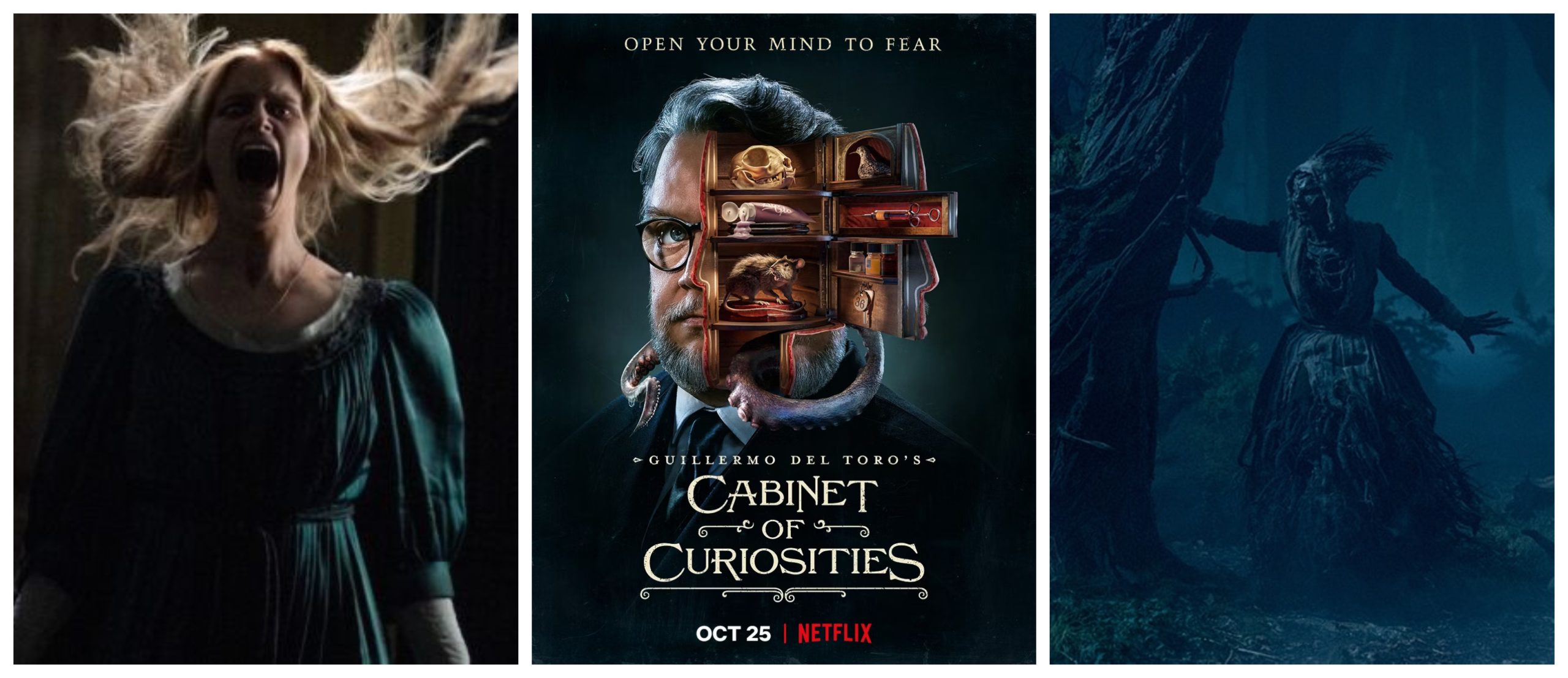
Netflix really stepped up its Halloween game this year, launching more exclusive horror series in October 2022 than any other non-themed streaming service in North America. Horror fans have grown accustomed to building their excitement for Mike Flanagan’s annual addition after The Haunting of Hill House series aired in 2018, but this year, a new player joined him in the ring. Guillermo del Toro has always been a master storyteller, and Cabinet of Curiosities is sure to be the feather in his cap.
Del Toro personally curated 8 short stories for this series, but he did not direct any of them himself. Instead, he invited 8 other directors to take on the challenge and gave them a powerful cast to help bring his vision to life. He appears in the opening sequence of every episode to set the audience up, much like Alfred Hitchcock did in Alfred Hitchcock Presents, slowly walking around a beautifully ornate cabinet, opening little doors, and removing mysterious objects to hint at what’s to come. He introduces the episode’s director by name, and places a statue representing them on a small table with the other objects he’s chosen, effectively engaging the viewer with both intrigue and nostalgia before the story even begins.
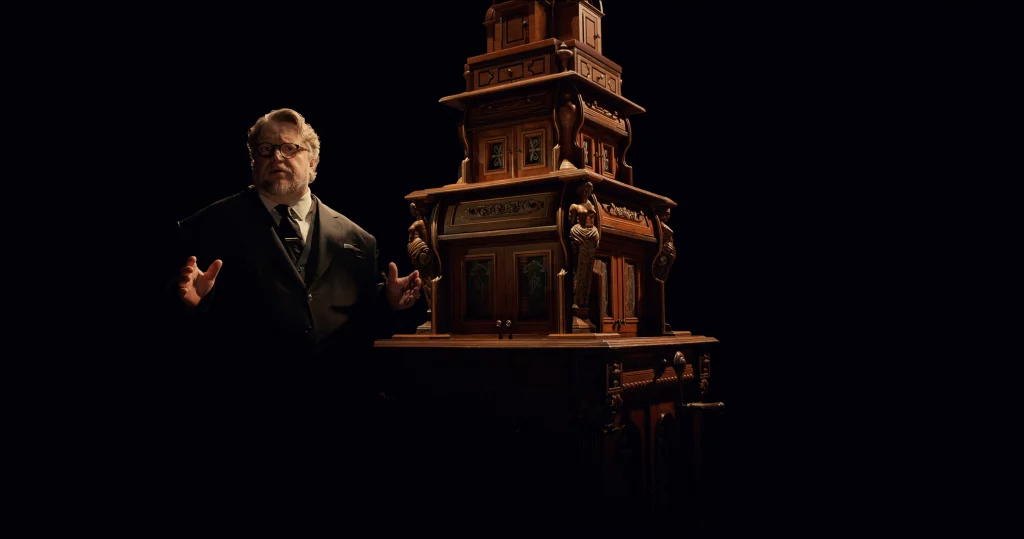
The cabinet itself is the focal point of the series; it’s where each story begins. A ‘Cabinet of Curiosity’, or ‘Cabinet of Wonder’, was originally a room filled with art, antiques, religious artifacts, taxidermied animals, and other historical relics that collectors acquired over time. They were displays of oddities from around the world in a time before travel was accessible to the general public, and owning one was akin to owning an exotic car now. Collectors used their cabinets to raise their status, hosting parties to show off their curiosities to society high brows who, if impressed, would invite the owner into their established circles. The cabinet as a furniture piece, like the one in this series, was created to sort and store smaller treasures within the room and was usually a mystical thing with secret doors and drawers built in to add to the mysterious feel of the collection. Del Toro’s cabinet is massive and will leave lovers of the lore desperate to explore it themselves.
The episodes in Cabinet of Curiosities offer a variety of themes and scare levels, and most of them are spectacular. There are scenes within these episodes that are not just visually stunning, they use effects that have never been seen before on screen. There are a few misses, of course, but when taken as a whole, this series sets a new bar for future Netflix Halloween specials. We’ve watched them all, and ranked them from the least scary episode to the one that still gives us nightmares.
8. The Viewing (7th episode)
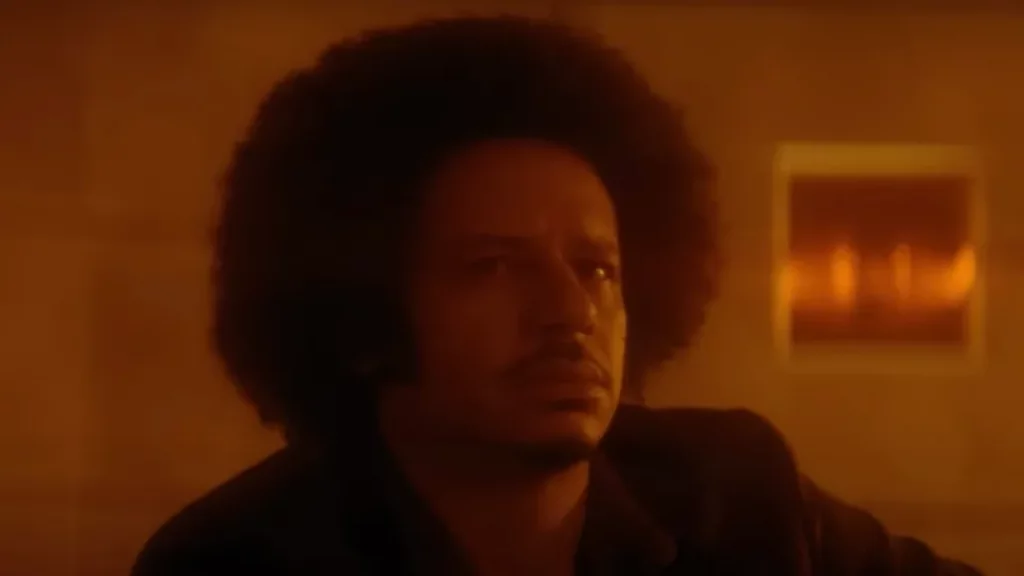
Director Panos Cosmatos (Mandy, Beyond the Black Rainbow) co-wrote this short with Guillermo del Toro and Aaron Stewart-Ahn (Mandy), and while it was visually striking, it was not scary at all. Set in 1979, a wealthy recluse with a penchant for cocaine invites four accomplished guests to go on a wild acid trip in his bizarre home. Filters are used to create a seductively 70s ambiance, firmly placing the viewer inside the belly of the story where they will experience the party members’ hallucinations right along with them, feeling more chaotic with every snort they take. Cosmatos casts a spell with little tricks like pinpoint flashes of light that mimic a dusty old film and lighting distortions that leave a granular cast, but the story takes so long to get to the point that it exits “slow burn” territory and lands in Boringsville. Its Lovecraft-style ending was unexpected and the cinematography is fantastic, but it does not satisfy the craving for something truly terrible.
7. The Murmuring (8th episode)
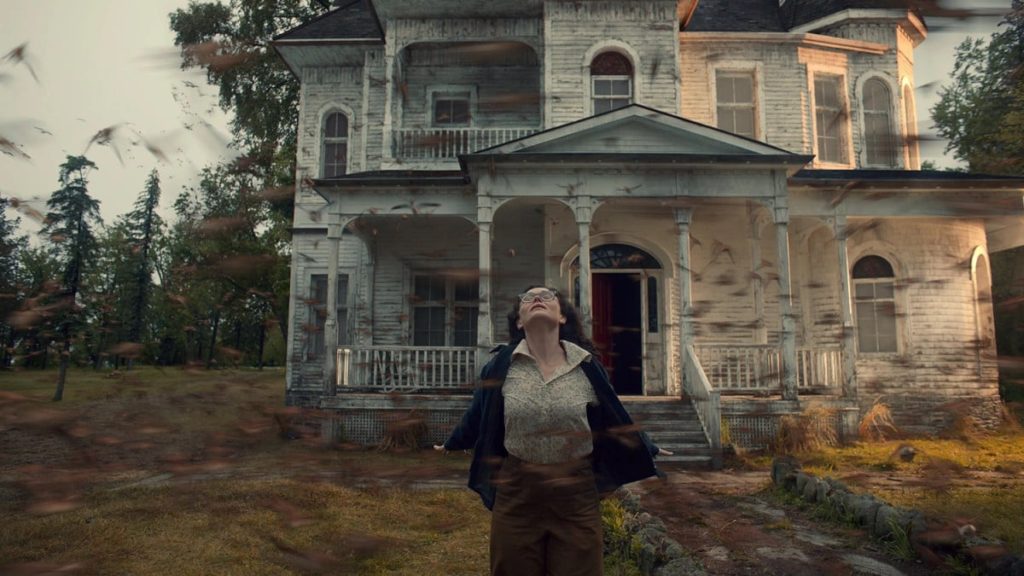
The Murmuring is nothing short of cinematic beauty. It’s the quintessential ghost story, filled with atmosphere and the kind of intrinsic sadness that seeps into your mind before you understand why it’s there. Set on a remote island, a middle-aged couple in mourning are drawn to the seclusion of a weather-beaten mansion, where they can set up their equipment to study the murmurations of a rare flock of birds. Written and directed by Jennifer Kent (The Babadook), and starring Andrew Lincoln (The Walking Dead), this episode is a powerful exposition of absolute loss. Kent’s use of the house and its surroundings to both amplify the growing rift between her characters and build quiet suspense is magical. When the ghosts finally arrive, we’ve already sunk into despair along with the mourning couple and are more saddened than frightened by them. While The Murmuring is certainly the best quality writing, directing, and acting in this series, it’s not very scary. Watch and appreciate it, but you won’t need to hide behind any pillows for this episode.
6. The Outside (4th episode)
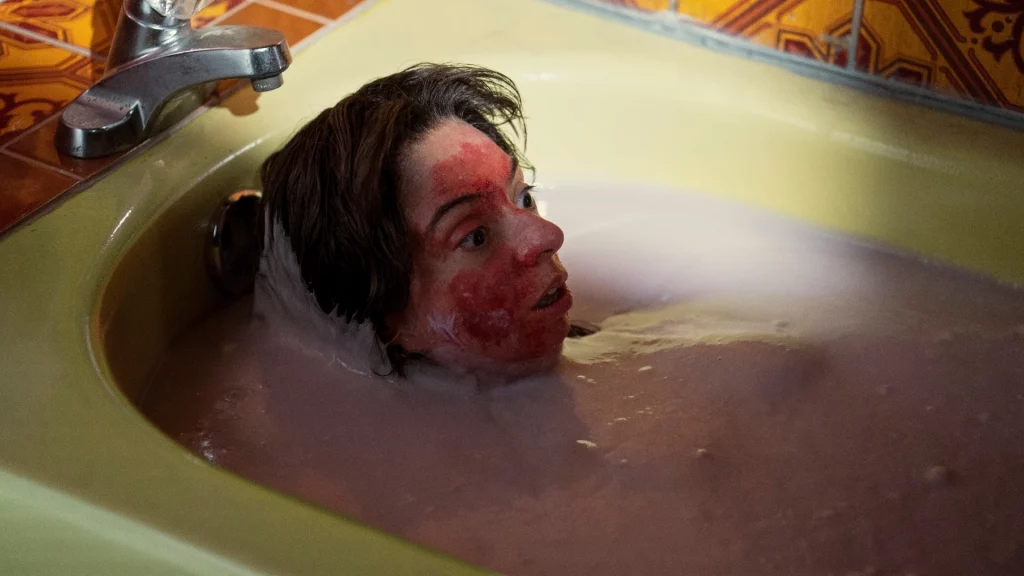
The Outside is by far the most comical episode in the cabinet, playing on Kate Miccuci’s tremendous ability for physical comedy. It’s borderline Splatterpunk horror in that it’s a story with a message about society: women are made to feel that they must do whatever it takes to be “beautiful”. Micucci (Garfunkel and Oates) stars as Stacey, a cock-eyed misfit who works in a bank full of 80’s style beautiful women by day, and taxidermies her hunting kills by night. Her husband Keith (Martin Starr, Silicon Valley) is an apathetic, obtuse police officer who barely acknowledges her existence. All Stacey wants is to become beautiful, so she can join the clique of superficial women she works with. When they give her a bottle of miracle cream for Christmas, she believes her dreams have been answered.
Directed by Ana Lily Amirpour (The Twilight Zone, Castle Rock), the horror aspects of this episode are twofold: a monster is born of one woman’s need to become beautiful, and the truth that society actually has pushed people to horrific extremes to “fit in”. There are valid points that come across in this story, and although it uses dark comedy to soften the edges, the messages are clear. It’s poignant, and Stacey’s drawn-out self-torture is uncomfortable to watch, it’s gross, but it’s not scary.
5. Graveyard Rats (2nd episode)
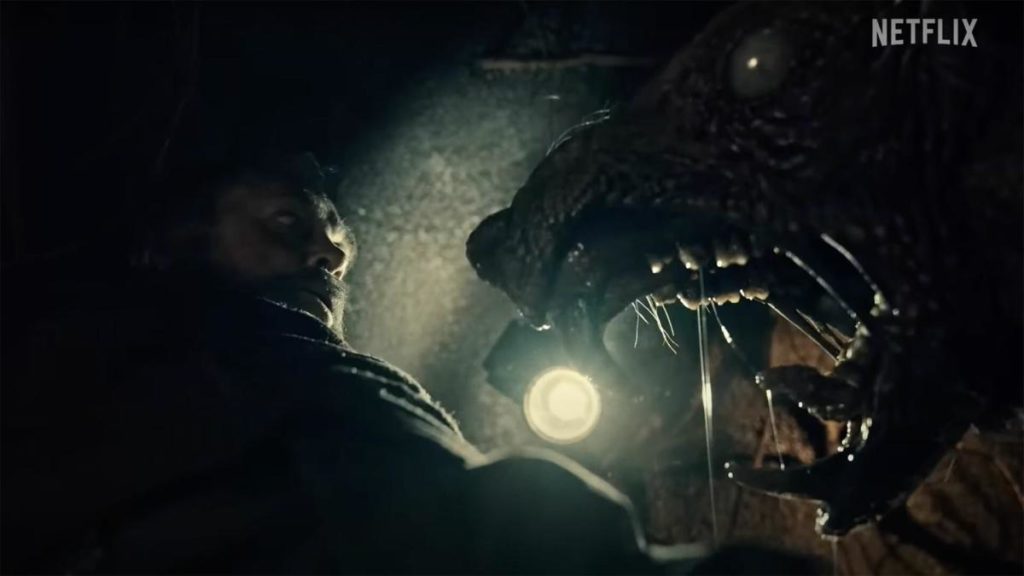
If you have any form of claustrophobia, do not watch this episode. Based on a short story by Henry Kuttner (The Cthulhu Mythos, Twilight Zone), director Vincent Natali (Cube, Splice) dares you to imagine what it would be like to be trapped in a narrow tunnel with a horde of rats, beneath a graveyard. It’s a morbid twist on a trope that was popular in Victorian/Gothic horror stories, featuring an unscrupulous grave keeper who steals jewels from the recently interred to pay his debts. All of the traditional “grave robber” details are covered, but the author’s addition of the rat infestation takes the story to a new level. One night, after digging down to someone he buried that day, the keeper discovers a pack of rats dragging the body through a hole they chewed in its coffin. We’re not surprised when he dives into the tunnel to follow them, but there is a moment when he becomes disoriented, and the cringe-inducing performance of the keeper transforms into a shared panic with the viewer as we wonder, too, which way is up.
Anyone who has anxiety around tight spaces or rats will likely rate this higher on the scare scale, but the “monster” in this story is just too ridiculous to take seriously. There was so much potential to make this a truly terrifying experience, but the cheese factor is just too high. It’s difficult to explain the disappointment without giving any spoilers, and the episode will certainly check a lot of boxes for most horror fans, but there’s a major element that just wasn’t necessary to the story and it cost Graveyard Rats a few points.
4. Pickman’s Model (5th episode)
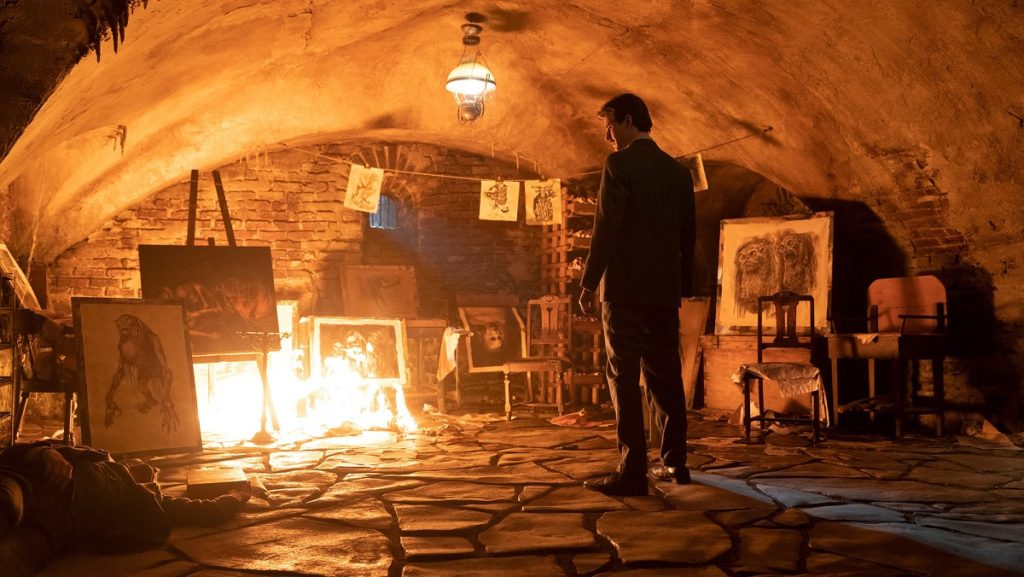
This story had great potential to create fear, but Crispin Glover’s indecision about which accent he wants to use is so irritating that it detracts from the impact of the writing. That being said, the premise of Pickman’s Model is haunting. Richard Pickman (Glover) is a disturbed artist in the derelict north end of Boston, renowned and spurned for the horrors he paints. As with many other Lovecraft tales, Pickman is distantly related to a victim of the Salem witch trials. Director Keith Thomas (Firestarter 2022, The Vigil) does a wonderful job building existential dread in the narrator, William (Ben Barnes, Chronicles of Narnia) who befriends Pickman and becomes obsessed with his work, slowly realizing that they are more than just paintings. Pickman’s subjects are Lovecraftian monsters, and some people experience hallucinations when they look at them. Reality begins to cant to the side when William thinks to ask the question: where does the artist get his ideas from? This episode has a wonderfully spooky atmosphere and would have placed higher on our list had Glover’s performance been better.
3. Lot 36 (1st episode)
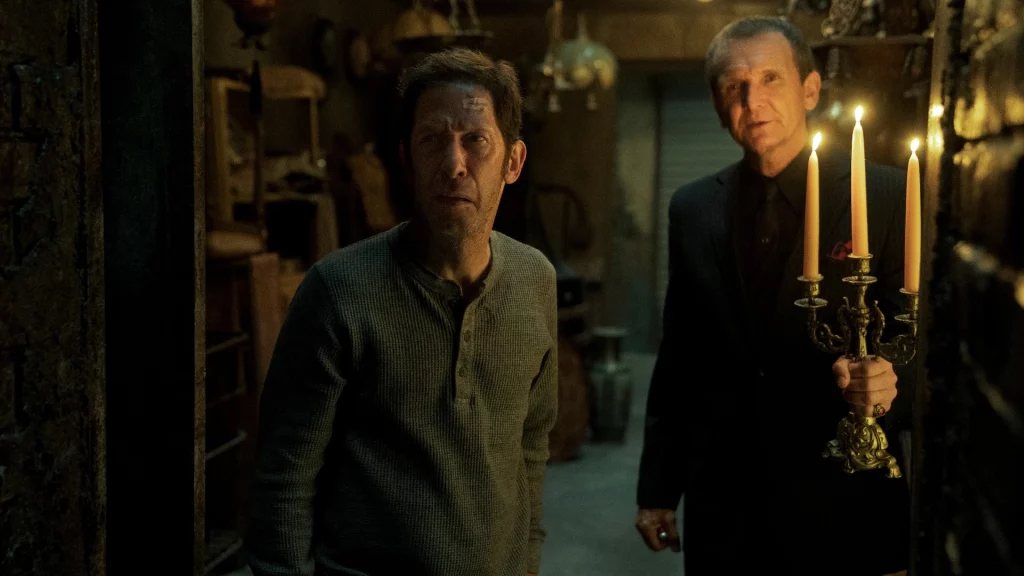
Del Toro released this series with one of his own short stories, a somewhat tame account of a nihilistic, anti-social war vet who places the winning bid on a repossessed storage locker. The episode opens with an elderly man chopping up an animal in his kitchen before falling over dead amidst the entrails. It’s his apartment contents in storage locker number 36. When winning bidder Nick Appleton (Tim Blake Nelson, Nightmare Alley, The Watchmen) opens the door, it looks like a junkyard. While sorting through the contents, he finds a few arcane objects that he’d like to have assessed, including a table with a beautiful inlaid pentagram. The horror in this episode begins when the dealer takes his finds to discover something hidden inside the table.
Lot 36 was directed by Guillermo Navarro, whose reputation as a cinematographer has him firmly established as a master of his profession (Pan’s Labyrinth, The Devil’s Backbone). Technically, the episode is almost flawless. Small details like the clicking sound of a light switch on a timer, in a deserted storage facility, in the middle of the night, go a long way in upping the perceived potential for danger, creating an instability that keeps our attention while we wait for the action to start. The story seems a little flat, though, lacking any adrenaline rushes that could have made the episode more memorable. We loved the dark witch/cult vibe in this one, but would have liked a little more punch.
2. Dreams in the Witch House (6th episode)
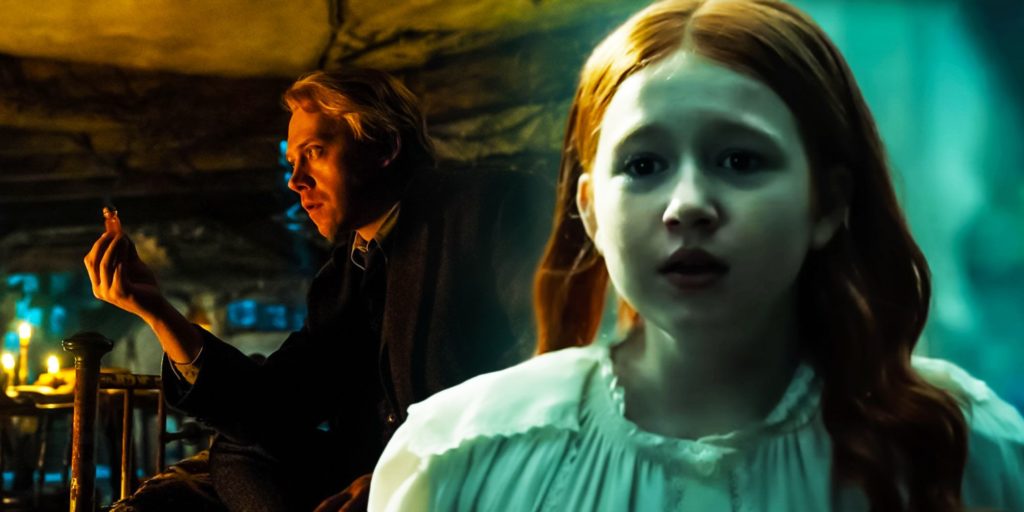
Catherine Hardwicke absolutely kills it as the director of this episode, bringing her cast and set to life unlike anything else seen in this series. It’s based on another H.P. Lovecraft story, but there are no tentacles in this one. Instead, a researcher of mathematics and the supernatural, desperate to reconnect with the twin sister he lost in childhood, finds a way to travel to the “other side”. It’s set in Massachusetts in the late 19th century, and Hardwicke captures the era perfectly with multiple sets and a large cast of extras all perfectly dressed for the period. Walter Gilman (Rupert Grint, Harry Potter, The Servant) discovers two important elements to help him cross over to search for his sister: a portal in the attic apartment of the Witch House, and an illicit drug that allows his mind to travel to other dimensions. The original owner of the house, Keziah Mason, was a witch who escaped from a Salem jail while awaiting her trial in 1692 and is said to either haunt the house or still live there (in hiding), if she still exists.
All of the sets are magnificent, but the attic is the epitome of creepy witchiness. Trees have long since overtaken the space, their branches weaving in and out of the rafters like evil vines. The portal to the other dimension is imaginative and beautiful even if it does originate inside a wardrobe, and the visual flow between the two settings is perfect. The most stunning aspect of this episode, though, is the visual effects used to create the witch. We are not going to describe her to you here because words can not do her justice, and we really want you to watch the episode for yourself, but we can promise that you’ve never seen anything like it before. It seems impossible to show us anything new at this point, but Hardwicke and her art/effects departments have done it. Whether you like the story or not, you’ll be impressed by the visual presentation of this episode and it’s truly scary witch.
1. The Autopsy (2nd episode)
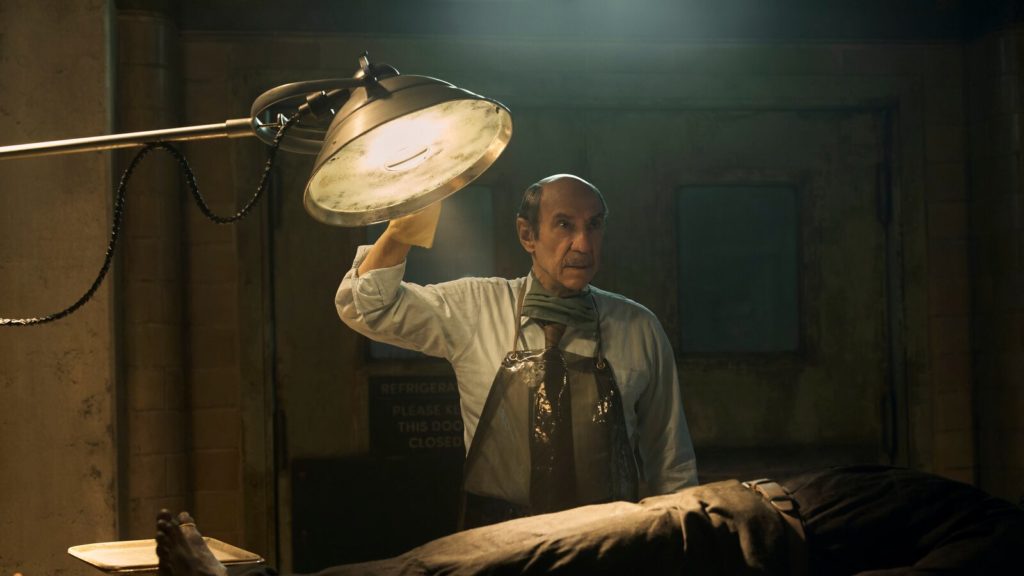
We will admit, we had to steel ourselves to mentally review parts of this episode to write about it. There were things done in this one that we’d never seen or read about before, and we’ve been around the horror block a few times. Directed by David Prior (The Empty Man), based on the short story by Michael Shea and adapted to screenplay by David S. Goyer (The Dark Knight), The Autopsy takes a while to build but ends with a thundering crescendo you’ll never forget.
Sheriff Nate Craven (Glynn Turman, Fargo, Mr. Mercedes) calls in his old friend Dr. Carl Winters (F. Murray Abraham, Mythic Quest, Homeland) to perform an autopsy when he finds a mutilated body tucked up into a tree. While investigating the death, an explosion at the local mine creates more bodies for Dr. Winters to examine. The deaths are all connected, and Nate hopes that Carl can prove it. It’s a small town without morgue facilities, so Carl is given a makeshift space with a cooler room to work in, and is left alone overnight to perform his autopsies. It’s spooky right from the get-go; the idea of being left alone in an old warehouse with half a dozen bodies to open up is enough to generate goosebumps. The camera is not shy, following Carl’s razor along every incision while he recites his findings for his old reel-to-reel audio recorder. Something is wrong, though, very wrong, and Carl might not make it through the night.
Many of the episodes in the Cabinet of Curiosities series are cinematic excellence; del Toro has high standards and would not put his name on anything less. The Autopsy, though, does more for the series in one hour than all of the other episodes combined. It doesn’t feel like it’s going to be something incredible until that first twitch in the cooler, and then it escalates at a steady pace with quietly disturbing special effects that will make the viewer hit the rewind button to verify that their minds weren’t playing tricks on them. What follows those moments in the cooler is a furious onslaught of horrific writing, acting, cinematography, directing, and effects that you will never forget. To say more would spoil the mystery in this story; just watch it. Keep a pillow close by if you’re squeamish.
In our opinion, Cabinet of Curiosities is a must-watch series for all horror lovers, and we hope to see more seasons from del Toro in the years to come.
Do you agree with our ranking? Let us know what you thought of the series!
More Lists
Confessions of a Serial Killer is a 1985 American horror thriller, written and directed by Mark Blair. Surprisingly, the film is the only writer/director credit to Mark’s name, never venturing… I first saw Alejandro Jodorowsky’s surreal, bildungsroman film, Santa Sangre, in 1989 on VHS tape. Watching it was like watching a slasher about a killer with a twisted Oedipal Complex… Born in 1946, Hideshi Hino stands out as a prominent Japanese horror artist, dedicating the majority of his life to conjuring various nightmares for his audience. Regrettably, in the Western… Panorama of Hell is a 1984 Japanese horror one-shot manga, written and illustrated by Hideshi Hino. Known as a master horror mangaka, Hino is most notable as the writer/illustrator for… Hey Mike Flanagan, we’ve found your next big project! New indie horror authors are crawling out of the woodwork every week, and just like indie films, their products are hit… Thine Ears Shall Bleed is a 2024 American period horror, written and directed by Ben Bigelow, with additional writing from William Bigelow. Previously working as writer and director of the… Regarded by many as Japan’s answer to Brigitte Bardot — both for her glamorousness and vaguely European looks (she wasn’t actually mixed-race) — Mari Atsumi became one of Japanese… Well-known in the extreme cinema community, Brian Paulin is a writer/director/editor/actor/key make-up effects artist for the film production company Morbid Visions in addition to playing guitar, drums, and singing for… In today’s world of flashy graphics and CGI, audiences have become immune to fantastical horror, pushing some writers to create content to test our boundaries with the extreme. In The… The femme fatale is one of the most compelling and enduring archetypes in film history, captivating audiences with their blend of beauty, mystery, and danger. These enigmatic women are uniquely…

Kate’s love of all things dark began as a child and deepened when she realized what being an adult meant. She was born with a pencil in her hand and loves nothing more than writing horrific stories to tantalize her inner demons. Kate lives in Hamilton, Ontario Canada with her husband and her boys, stirring up trouble wherever she can.